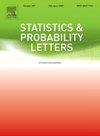具有再感染和复发的随机广义 SIRI 流行模型的静态分布
IF 0.9
4区 数学
Q3 STATISTICS & PROBABILITY
引用次数: 0
摘要
本文提出并研究了具有两个广义发病率函数的随机 SIRI 流行模型。我们首先研究了具有正初始值的随机 SIRI 模型全局正解的存在性和唯一性。然后,我们得到了随机流行模型中疾病消亡的充分条件,并发现大噪声会使疾病以指数形式消亡。同时,我们得到当 R0s˜ 大于 1 时,随机模型的解具有唯一的静态分布。我们的结果表明,白噪声的强度会影响模型的动力学行为。最后,我们用数值模拟来说明理论结果,并应用随机模型和确定性模型来分析塞尔维亚 COVID-19 疫情的爆发。本文章由计算机程序翻译,如有差异,请以英文原文为准。
Stationary distribution of a stochastic generalized SIRI epidemic model with reinfection and relapse
In this paper, we propose and investigate the stochastic SIRI epidemic model with two generalized incidence rate functions. We firstly study the existence and uniqueness of the globally positive solution to the stochastic SIRI model with positive initial value. Then we obtain sufficient conditions for the extinction of the disease in the stochastic epidemic model, and find that the large noise can make the disease die out exponentially. Meanwhile, we obtain that the solution to the stochastic model has a unique stationary distribution when is greater than one. Our results show that the intensity of white noise can affect the dynamical behaviors of the model. Finally, we use numerical simulation to illustrate theoretical results, and apply both the stochastic and deterministic models to analyze the outbreak of COVID-19 epidemic in Serbia.
求助全文
通过发布文献求助,成功后即可免费获取论文全文。
去求助
来源期刊

Statistics & Probability Letters
数学-统计学与概率论
CiteScore
1.60
自引率
0.00%
发文量
173
审稿时长
6 months
期刊介绍:
Statistics & Probability Letters adopts a novel and highly innovative approach to the publication of research findings in statistics and probability. It features concise articles, rapid publication and broad coverage of the statistics and probability literature.
Statistics & Probability Letters is a refereed journal. Articles will be limited to six journal pages (13 double-space typed pages) including references and figures. Apart from the six-page limitation, originality, quality and clarity will be the criteria for choosing the material to be published in Statistics & Probability Letters. Every attempt will be made to provide the first review of a submitted manuscript within three months of submission.
The proliferation of literature and long publication delays have made it difficult for researchers and practitioners to keep up with new developments outside of, or even within, their specialization. The aim of Statistics & Probability Letters is to help to alleviate this problem. Concise communications (letters) allow readers to quickly and easily digest large amounts of material and to stay up-to-date with developments in all areas of statistics and probability.
The mainstream of Letters will focus on new statistical methods, theoretical results, and innovative applications of statistics and probability to other scientific disciplines. Key results and central ideas must be presented in a clear and concise manner. These results may be part of a larger study that the author will submit at a later time as a full length paper to SPL or to another journal. Theory and methodology may be published with proofs omitted, or only sketched, but only if sufficient support material is provided so that the findings can be verified. Empirical and computational results that are of significant value will be published.
 求助内容:
求助内容: 应助结果提醒方式:
应助结果提醒方式:


